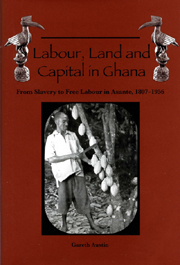Book contents
- Frontmatter
- Contents
- List of Illustrations
- List of Tables
- Preface
- Note on Names
- Maps
- Note on the Maps
- 1 Introduction
- Part I Context and Concepts
- 2 Theories and Debates: Some Tools for Thinking about the History of Property and Markets in Asante and Beyond
- 3 Asante, 1807–1956: The State, Output and Resources
- 4 The Changing Relationship Between Inputs and Output, 1807–1956
- Part II Social Relations of Production and Trade, 1807–1896: Absent and Imperfect Factor Markets
- Part III Slavery as Hobson's Choice: An Analysis of the Interaction of Markets and Coercion in Asante's Era of ‘Legitimate Commerce’, 1807–1896
- Part IV The Decline of Coercion in the Factor Markets of Colonial Asante: Cocoa and the Ending of Slavery, Pawnship and Corvée, 1896–c.1950
- Part V Social Relations of Production and Trade, 1908–1956: Towards Integrated Factor Markets?
- Part VI Freedom and Forest Rent, 1908–1956
- Abbreviations Used in the Notes
- Notes
- List of References
- Index
3 - Asante, 1807–1956: The State, Output and Resources
from Part I - Context and Concepts
Published online by Cambridge University Press: 12 September 2012
- Frontmatter
- Contents
- List of Illustrations
- List of Tables
- Preface
- Note on Names
- Maps
- Note on the Maps
- 1 Introduction
- Part I Context and Concepts
- 2 Theories and Debates: Some Tools for Thinking about the History of Property and Markets in Asante and Beyond
- 3 Asante, 1807–1956: The State, Output and Resources
- 4 The Changing Relationship Between Inputs and Output, 1807–1956
- Part II Social Relations of Production and Trade, 1807–1896: Absent and Imperfect Factor Markets
- Part III Slavery as Hobson's Choice: An Analysis of the Interaction of Markets and Coercion in Asante's Era of ‘Legitimate Commerce’, 1807–1896
- Part IV The Decline of Coercion in the Factor Markets of Colonial Asante: Cocoa and the Ending of Slavery, Pawnship and Corvée, 1896–c.1950
- Part V Social Relations of Production and Trade, 1908–1956: Towards Integrated Factor Markets?
- Part VI Freedom and Forest Rent, 1908–1956
- Abbreviations Used in the Notes
- Notes
- List of References
- Index
Summary
This chapter delineates the changing political, economic and ecological settings in which resources were put to work over the period. Section A outlines the political institutions and policies within which Asantes pursued their livelihoods. It describes the structure of government and assesses what the states (precolonial and colonial) claimed to do and what they lacked the power to do. Section B surveys the output of goods and services, from which the demand for factors of production derived. It summarizes the varieties and approximate scale of subsistence and extra-subsistence economic activity. Section C describes the stocks of labour, land and capital. Finally, Section D draws together the implications of the previous sections for markets and property rights in productive resources. The primary purpose of the chapter is to provide a foundation for the analysis developed in subsequent chapters. But the discussion is also intended to contribute directly to the literature: on various specific points, and in the sense that the overview of economic activity and resources presented here is the first to be offered for the colonial era in Asante, let alone for our period as a whole.
Government: Structure, Pretensions, Limitations
This section begins with a description of the structure of government, vertical (the hierarchy) and horizontal (the metropolis and the provinces), and of the major conflicts and changes over the period. I then outline the demands and claims made by the nineteenth-century kingdom and by the colonial regime on the population, especially fiscal.
- Type
- Chapter
- Information
- Labour, Land and Capital in GhanaFrom Slavery to Free Labour in Asante, 1807–1956, pp. 34 - 71Publisher: Boydell & BrewerPrint publication year: 2005

